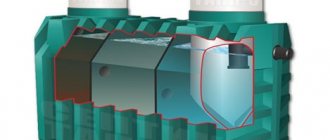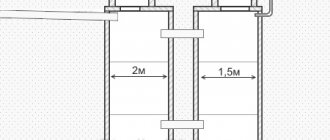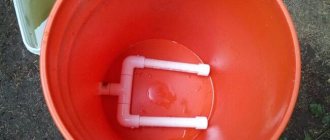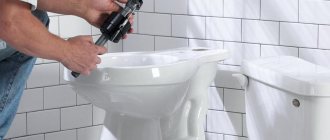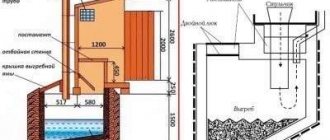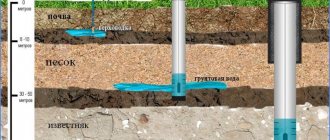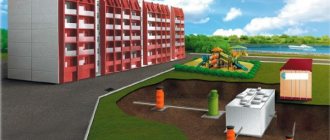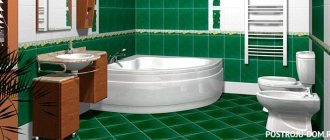Where should the cesspool be located?
First, you need to decide on the area where the cesspool system will be installed.
- directly on the site adjacent to a private or country house;
- it is possible to arrange at a distance of at least 10 meters from the foundation of a residential building and other buildings on the personal territory and to the structures located in the neighborhood;
Important! This requirement is based on the fact that if a leaky pit is installed closer without pumping, the foundations of nearby buildings may be destroyed, as well as their flooding.
- the distance from the pit to the fence is also regulated and must be at least one meter;
- the depth should not be more than 3 meters. When choosing, you need to take into account the depth of groundwater;
- the pit must be located at a certain distance (25 meters) from drinking wells.
This distance depends on the type of soil in the garden area:
- For clay soil - no closer than 20 meters;
- For loamy soil - no closer than 30 meters;
- For sandy loam and sandy soil, the cesspool cannot be installed closer than 50 meters from the well.
Cleaning
The construction of a cesspool is just the beginning of its operation, so it is important to know how to clean a cesspool; it is difficult to do this without pumping. If the pit has a filter bottom, then it is advisable to regularly use preparations for cesspools of a chemical or biological type. They will turn solid fecal matter into liquid, and it will pass through the filtration layer.
If the pit has a bottom, then the mentioned means will also be useful here, but they will only remove the characteristic odor and somewhat reduce the volume of waste water; this will practically not affect the regularity of pumping, since there is simply nowhere for the liquid to go.
Creating such a seemingly simple structure as a cesspool requires careful attention to all stages. Only its construction in accordance with all the rules will allow the pit to be used for decades without repairs or other difficulties. The only thing you have to do from time to time is to change the drainage layer in a hole without a bottom and pump out the wastewater in a hole with a bottom.
DIY cesspool system
There are two main types of pit arrangement:
- sealed;
- regular without bottom.
The option for arranging a sewer system in a country or private house is determined by the location of the territory, the daily amount of wastewater and the material capabilities of the owner of the site:
- if the daily amount of wastewater is no more than one cubic meter, it is possible to build a simple system without a bottom and without pumping. In this type of pit, the wastewater partially goes into the ground, where it is purified by anaerobic bacteria. An example of this cesspool is the classic rural toilet;
- with a large amount of wastewater (more than a cubic meter), the construction of a sealed structure is required, which must be pumped out from time to time.
This requirement is explained by the fact that in the absence of a bottom in the pit, wastewater passes into the ground and its purification occurs by microorganisms located in the thickness of the earth. But their cleaning capabilities are not limitless.
With large amounts of wastewater, microorganisms cannot cope with water purification. In this case, the wastewater will begin to pollute the adjacent area and may pass into water-bearing soil layers with further contamination of the drinking well.
If you need to dispose of a large amount of wastewater, you can consider installing a septic tank with filtration fields.
Volume calculation
To calculate the volume of a drainage type tank, you can use the following formula: V=(Vn×N)×3, notation:
- V – volume of a drainage type tank for wastewater;
- Vn is the volume of water consumed by a person during the day, it ranges from 0.15 to 0.2 m3;
- N is the number of people living in a country house or in a private house.
Coefficient 3 is introduced based on the consideration that the tank capacity should be three times the daily water consumption.
After making the calculation, we recommend making a reserve of at least 20%. For example, four people live in a house, therefore, the calculation will be as follows: V = (0.2 × 4) × 3 = 2.4 m3. We add a margin of 20% and get the result that the tank must have a volume of at least 2.88 m3.
Note that over time, a cesspool without a bottom will still require cleaning, but it does not need to be done as often as when a sealed design is used.
Do-it-yourself ordinary sewer pit
The simplest waste system is done like this:
- a pit is dug up to two meters deep, two meters wide and up to three meters long;
- earth walls are laid or fixed;
- a layer of crushed stone is poured down;
- A protective ceiling with a lid is installed on top.
The main advantages of a pit without a bottom:
- ease of use;
- low cost of design and operation;
- simple and quick DIY construction.
Disadvantages of a pit without a bottom:
- the groundwater level must be below the level of the sewage system;
- not suitable for draining large quantities of sewage water;
- environmentally unsafe;
- unscheduled filling due to rainwater is possible;
- has an unpleasant odor.
Preparatory work
Having decided on a location for the storage tank, excavation work begins. This is the first stage in the construction of any type of autonomous sewage system. The pit is dug according to calculations made on the optimal volume of the cesspool. The depth of the sump should not exceed 3 meters, this will allow pumping from the very bottom in case of siltation. The walls of the pit are leveled for subsequent installation of the selected material.
Advice. You can save on calling an excavator to dig a pit if you do it simultaneously with the construction of the foundation of the house.
Sealed waste pit
A sealed sewer system is a sealed container into which sewage water is pumped through pipes. As the container fills, sewage water must be pumped out with a special machine.
The main advantages of a sealed system:
- the installation location does not depend on the type of soil on the site;
- does not depend on the passage of groundwater;
- environmentally friendly, sewage water does not enter the environment.
Disadvantages of a sealed design:
- a smell appears if the storage tank is made in the shape of a well;
- monthly costs (you need to periodically call a sewer truck for pumping);
- relatively high construction cost.
Choosing a place for the pit
The placement of waste collection facilities is determined by special rules and regulations. These recommendations make it possible to protect water supplies, the foundation of the house and green spaces from contamination in the event of an increase in the water level in the drainage pit. Sanitary rules determine the following distances:
- to the reservoir – 30 m:
- to the well with sandy soil - 50 m, with clay soil - 20 m;
- to trees – 3 m;
- at least 5 m to the foundation of the house;
- to the border of the neighboring plot - 2 m.
It is important to take into account the topography of the area; a low-lying area is not suitable for installing a drain tank. During rainfalls and snow melting, water will fill the hole. The depth of groundwater is also taken into account; it should be 1 meter lower from the bottom of the storage tank.
How to build a drainage hole with your own hands
Let's look at different types and methods of designing drainage systems that you can make with your own hands. They are conventionally divided into permanent and temporary.
From car tires
If you need a flush system for a toilet in a country house at minimal cost, you can make it yourself using old car tires.
This is a quick and budget option for constructing a sewer pit. The design is quite simple. A pit is made where old tires are laid one on top of the other. A layer of crushed stone is poured onto the bottom of the pit; if desired, the tires are sealed with a clay lock.
Advantages:
- if necessary, it can be easily restored;
- durability;
- speed, simplicity and low cost of construction.
Flaws:
- tires rot over time;
- the possibility of a negative impact on the environment due to high load on the structure;
- rapid silting with insufficient cleaning and pumping, resulting in loss of usable area.
Made from concrete rings
This is another way to quickly build a drain system. Its design is similar to a well. The rings are installed on top of each other. The connections between them, if desired, are sealed using a cement screed.
By its design, a sewer pit made of concrete rings is more of a sealed structure. Therefore, you need to pump it out regularly . Although there is an option to install a septic tank made of concrete rings.
Main advantages:
- Convenience of installing a protective cover with a hatch;
- durability;
- possibility of construction with your own hands;
- relatively low cost.
Flaws:
- the possibility of an unpleasant odor coming from ventilation pipes;
- the need for periodic pumping;
- complexity of installation.
Brick drainage pit
This is the most successful and optimal option if you need a drainage system for a toilet or bathhouse in a country house.
Advantages:
- ease of construction - almost any summer resident can handle laying bricks for a drainage pit;
- environmental friendliness - the contents of the drainage structure are periodically pumped out by a sewage disposal machine.
Flaws:
- siltation. Siltation can be prevented by constantly pumping out the liquid in the storage tank;
- relatively short service life (up to 20 years), as a result of brick destruction in unfavorable conditions of the drainage system;
- Occasionally, an unpleasant odor may form. The use of various drugs that accelerate waste decomposition processes and timely pumping of the storage tank can help cope with this.
Design and features of septic tanks without pumping
By spending a little money, you can build a more advanced drainage system - a septic tank. Its difference from a simple sewage pit lies in the presence of several tanks designed to process sewage by anaerobic bacteria. During the decomposition of organic waste, it is transformed into a homogeneous mass and the foul odor is neutralized. In modern systems, the capabilities of biological processing and gravity sedimentation are complemented by forced post-treatment methods. The use of bioloading and biofilters allows you to filter up to 95% of wastewater. Unlike a cesspool, an anaerobic process occurs in septic tanks, due to which all bottom sediment is processed into sludge and liquid.
The presence of several chambers allows the use of an anaerobic method of wastewater purification with its subsequent discharge into a filtration well
Dividing the sewer tank into several tanks allows you to install an overflow system. Thanks to it, the wastewater goes through several stages of purification, which make it possible to obtain water at the outlet of the device, suitable for watering the garden and other household needs. If there is no need for this, then the excess liquid is simply drained into the ground, installing a filter bottom in the last chamber.
Just like a cesspool, you can build a septic tank with your own hands. Of course, it has a more complex design, but its manufacture does not require any expensive materials.
By deciding to install a septic tank on your property, you get a lot of benefits:
- absence of unpleasant odor due to hermetic design;
- you can completely dispense with the services of a sewer truck by using the sludge residue as fertilizer for the garden;
- the risk of groundwater contamination by sewage is greatly reduced;
- The multi-stage cleaning system operates effectively for a long time, ensuring constant sewage throughput;
- A septic tank is a structure that practically does not change the ecological balance of the area.
The disadvantages of treatment facilities of this type include:
- complicated design, involving the installation of several chambers, overflow and filtration systems;
- the need for complete tightness of the structure;
- higher construction cost compared to a cesspool.
As you can see, the disadvantages of a septic tank are few and are associated with the complexity of the design, which ultimately leads to higher construction costs. As for operating costs, they are considered insignificant.
Construction of a brick cesspool
First you need to decide on the location of the drainage pit, following all the rules and taking into account ease of use.
We choose a design. Depending on the purpose, the brick drainage pit can be rectangular, square or round .
We calculate the required volume, dimensions and prepare a foundation pit for the pit.
With a rectangular design, we tilt the bottom to the side to install the hatch. Place a 20 cm layer of sand at the bottom of the hole and fill it with cement mortar. You can take a ready-made reinforced concrete slab of the required dimensions. A cement screed is made on top.
We are laying the walls. The optimal wall thickness is 30 cm. It is advisable to lay the walls in a checkerboard pattern of half a brick. Quarter brick installation is possible.
Then, when the walls are ready, you need to treat them with bitumen mastic or make a clay castle on the outside for better sealing. If necessary, we plaster the inner surface.
Installation of hatch and ceiling
Then, when the base of the drainage pit is ready, we install a ceiling with a hatch. The ceiling must cover the perimeter of the hole by at least 50 cm
Concrete slabs are chosen as the ceiling or logs are carefully laid. When arranging a septic tank, you need to provide a location for the hatch. The hatch is made measuring 70 cm.
On top of the stele ceiling, waterproofing is made of film or roofing felt. We cover the waterproofing with a layer of slag or soil measuring 0.5 m.
Attention! To protect against the appearance of odors from the drainage pit and its freezing, the hatch in the pit is installed double. The top cover is located on the surface of the ground, and the other at the ceiling level. The space that appears in the bow is filled with heat-insulating materials (slag, expanded clay, polystyrene foam, etc.).
Insulation of a septic tank
The water in the pit does not freeze because fermentation processes raise the temperature. But cooling the liquid on the surface inhibits the activity of bacteria that clean sewage. Therefore, it is still recommended to insulate . At least half the depth of soil freezing in the region.
The insulation can be expanded clay , which is covered with a layer 25-40 PSB-25 foam boards with a thickness of 5 to 10 centimeters.
Expanded polystyrene has good thermal insulation properties. Here is our material about it - technical characteristics of PSB S 35 thermal insulation.
Sewage pit from a barrel
This is an excellent option for arranging water drains with your own hands with natural cleaning of cesspool sewers with small amounts of waste (up to 1 cubic meter).
Barrel preparation:
- We use a 200 liter barrel, preferably from a material that does not corrode, we make holes in the wall in a checkerboard pattern for drainage using a drill or grinder. It is advisable to make holes at a distance of 15-25 centimeters;
- We tightly attach a pipe to the bottom of the barrel to connect the drain pipe. To ensure sealing, you can use silicone sealants. We treat the connection area of the pipe with mastic;
- We wrap the barrel in geotextile and secure it firmly with twine. This is necessary to ensure that the container is protected from soil and other foreign particles entering its structure while maintaining normal drainage.
Installation of a cesspool sewer system:
- we make a trench and lay sewer pipes, always with a slope;
- we prepare a pit with a depth and size slightly higher than the depth of the barrel;
- down the pit we fill gravel or crushed stone with a layer of 20 cm;
- We place a barrel on this pillow and connect the drain pipe;
- fill the resulting space between the walls of the pit and the container with gravel or crushed stone;
- We connect the sewer pipe to the installed pipe.
Now the sewer pit for your bathhouse is ready. You can also make a toilet drain pit with your own hands.
Details
Cleaning with pumping
You can remove excess waste by hand using a bucket with a rope. In a country house with a small hole, this option is possible. During work, you should wear a special suit to protect your skin from the aggressive environment of the wastewater.
Attention! During mechanical cleaning of pits, suction pumps are used, which are special equipment that is used to pump out the container, then removing the wastewater for disposal.
It is also necessary to protect the respiratory tract, because the effluent contains methane, which is dangerous to humans. You cannot clean the pit alone when working inside the pit, because you can lose consciousness and drown in the drains. In addition to the suit, gloves and rubber boots are worn. Effluent should only be pumped into a sealed container so that it can be easily transported to a designated disposal site.
Attention! The sewer truck should be located at a distance of up to 4 meters from the pit. This nuance should be taken into account when organizing a cesspool.
The manual pumping method is dangerous and labor-intensive. If possible, it is better to use a pump instead of a bucket to pump out feces. Working with it will be quick, safe, and without contact with feces. An easier cleaning method is to use a suction pump. The machine is equipped with a wide pumping hose; it will drive up to the site and pump out the sewage. For pits with a depth of more than 3 meters, this machine is not suitable, however, cesspools with such a depth, as a rule, are not constructed.
To save on paying for the services of sewer trucks, when constructing a pit, you need to calculate its volume so that during pumping it is equal to a multiple of the capacity of the special equipment. It should be remembered that pumping is carried out when the pit is filled to 2/3 of the total volume of the container.
Biological method of wastewater treatment
Different types of septic tanks can be cleaned using microorganisms that break down sewage. Cesspools can also be cleaned using special biological products. The products help remove the pungent smell of sewage from the pit.
Attention! Some types of drugs require special preparation before use, for example, pre-dilute in water.
After pumping with a suction pump, an unpleasant smell of wastewater remains in the area. Biological cleaning agents will cope with this task. You need to choose the optimal drug, follow the instructions, and apply it. Products can be purchased in the form of gel, powder, liquid. Beneficial bacteria break down wastewater into water and sludge that accumulates at the bottom. After such purification, water cannot be used for household purposes. But this measure reduces the speed of filling the pit. Sediment in the form of sludge will also have to be pumped out periodically, involving sewer trucks.
Attention! Not all types of wastewater can be treated with bacteria.
Particles of inorganic debris settle to the bottom, thus reducing the usable space in the pit. Chlorine-containing detergents can kill bacteria. When using a dishwasher, you should be careful in this regard.
Chemical method of wastewater treatment
To reduce the volume of wastewater, chemicals are used. They can be dangerous to humans and nature. To remove waste, use:
1.formaldehyde.
2. ammonium salt.
3.nitrate type oxidizers.
The low price of formaldehyde is the only advantage of the product. The substance itself is very dangerous, it is toxic and can cause cancer. This remedy is rarely used.
In terms of safety, products based on nitrate oxidizers have better characteristics. Their composition is similar to fertilizers containing these substances. If you dose the drug correctly, following the instructions, the cleaning product will be safe. The drugs have a high price, which is justified because the drugs are highly effective. Oxidizers dilute wastewater, eliminating harmful odors. After the effect of the drug has expired, you can pump out the sewage using a pump.
Attention! Nitrate oxidizers do not lose their effectiveness under aggressive conditions.
The drugs are not affected by household chemicals that enter the sewer system during life. These drugs can effectively clean the entire sewer system, including the pit.
The use of ammonium salts also needs to be done with caution, as with all aggressive chemicals, it can be hazardous to health. Before use, you should study the instructions and adhere to them during operation. If the drain contains chlorine, the effectiveness of the product may decrease, but the unpleasant odor will still disappear.
When determining which cleaning method is suitable, it is necessary to take into account the characteristics of a particular situation. For example, for a cesspool under a toilet, you need to choose products that break down paper.
Concrete drainage pit
As an option for arranging a home sewer system, you can consider installing a concrete cesspool.
Stages of constructing a concrete pit:
- calculate the required volume of the drainage pit;
- digging a pit of the required size;
- We install formwork around its perimeter and fill it with concrete solution;
- These walls are treated from the outside with bitumen for waterproofing;
- on the bottom of the pit we pour a layer of broken bricks, gravel, crushed stone;
- We install waterproofing made of film or roofing felt on the walls of the structure, as well as a ceiling with a hatch and a hole for connecting a sewer pipe. The ceiling can also be made independently from concrete;
- we lay and connect sewer pipes.
Using this technology, you can make a toilet drain pit with your own hands.
How to solve the sludge issue
The process of siltation is considered a serious problem for a cesspool. The silty layer at the bottom does not allow runoff to penetrate into the soil. It is necessary to pump out sludge frequently so as not to reduce the volume of the wastewater tank.
The unpleasant smell of hydrogen sulfide from the pit indicates the formation of sludge. In this situation, it is necessary to neutralize the drains, then pump out the remaining sewage.
Attention! If the pit often silts up, it is worth considering improving the design by adding an additional container and an overflow system.
Sludge deposits are removed from the walls and bottom using chemicals and mechanical cleaning. Combining the two methods will give better results. A large mass of wastewater is removed mechanically, then a high pressure of water is supplied to the tank from a hose. The water will wash away the sludge deposits inside the container, breaking them into individual particles. Wash down the walls until the tank is filled with liquid to twenty-five percent. Next, pumping is carried out using a pump, or using a sludge extractor for disposal.
Chemical cleaning involves using chemicals to dissolve solid debris. For example, using nitrate cleaners is suitable. They dissolve sludge well. It will turn into liquid, which can then be easily pumped out.
Attention! After cleaning the absorption well, the filtration pad is replaced. They rake out the old layer, covering it with a layer of gravel with sand and crushed stone.
Using chemicals is more expensive than pumping. But the procedure is much simpler, taking less effort and time. When removing sludge manually, you will have to endure the dirt. Cesspools that do not have a bottom require cleaning and replacing the filtration layer consisting of sand and gravel.
To prevent siltation of the cesspool, wastewater should be drained to the filtration field. The system is thought through when designing the structure. This requires installing a horizontal sewer pipe at a height equal to the floor of the pit tank to drain the flowing waste.
The filtration field requires excavation of the soil to the layer in which the outlet pipe is laid. Agrofibre is laid underneath, then covered with crushed stone. The pipe coming out of the pit is placed on this layer. The pipe is made with perforation; for this, holes should be made at the same distance. It is necessary to pour a layer of crushed stone onto the pipe rolling and cover it with agrofibre. As a result, the pipe will end up in a circle in the filtration layer. Liquid sewage will quickly seep through the filtration bed and be disposed of in the soil.
Project preparation
Even the simplest design of a septic tank or cesspool requires calculations, because the size of the structure depends on the daily amount of wastewater and other conditions. Only correct design will give confidence in the efficiency and reliability of the structure, and pre-drawn drawings will allow you to avoid errors in work.
Material calculation
The number of rings is calculated based on the volume of wastewater, which, in turn, is determined based on the amount of water consumed by the family. In your research, you can use average water consumption data per person in the amount of 200 liters per day or resort to the help of special tables.
Dependence of the volume of the septic tank on the number of family members
To calculate the size of the receiving tank, the amount of wastewater per day is multiplied by three. Based on this value, the number of concrete rings and their size are determined. For example, for a family of 3 people, a primary chamber of 1.8 cubic meters will be required. m. (600 liters per day multiplied by 3). For this, two standard rings with a diameter of 1 m and a height of 0.9 m will be enough. If 8 people live in the dacha, then you will need a tank of 4.8 cubic meters. m, which is about seven reinforced concrete products. Of course, no one will build a seven-meter deep septic tank. In this case, take three rings with a diameter of 1.5 meters.
When making calculations, you can use size tables of standard reinforced concrete structures and formulas for determining the volume of a cylinder. For the most common rings with a diameter of 1000, 1500 and 2000 cm and a height of 0.9 m, the internal volume is:
- KS-10.9 – 0.7 cu.m. m;
- KS-15.9 – 1.6 cu.m. m;
- KS-20.9 – 2.8 cubic meters. m.
In the marking, the letters indicate “wall ring”, the first two numbers are the diameter in decimeters, and the third is the height in tenths of a meter.
The minimum size of the post-treatment chamber must be at least 1/3 of the total volume of the septic tank
The size of the post-treatment chamber is calculated based on the fact that the first chamber occupies 2/3 of the volume of the septic tank, and the second – the remaining third. If we apply these ratios to our example of a treatment system for 8 people, then the second container should have a volume of 2.4 cubic meters. m. This means that you can install 3 - 4 concrete elements KS-10.9 with a diameter of 100 cm.
The dimensions of the pit should be significantly larger than the diameter of the tank, since after laying the rings it will be necessary to seal the septic tank from the outside. If it is impossible to use earthmoving equipment, this creates additional difficulties. However, it is worth making a larger hole and following the technology, rather than digging in rings by settling them under their own weight. Treating cracks only from the inside is fraught with seepage of sewage into groundwater.
When calculating the amount of materials, be sure to take into account the depth of the drain line, taking the entry point of the pipe into the septic tank as the upper level of the receiving chamber. The size of the structure is increased by an amount sufficient to ensure that the floor slab is 5–10 cm above the surface of the site. To do this, use one or two standard rings, and, if necessary, supplement them with additional elements. If this is not possible or there is red brick left after the construction of the dacha, then the upper part of the septic tank chambers is built from it.
Drawing
Before starting excavation work, a detailed drawing of the structure is drawn up, indicating the depth, entry and exit points of pipelines, and levels of the overflow system. Since the distance from the surface of the site to the bottom point of the sewer main depends on the degree of soil freezing, these values differ depending on the region and soil composition. In addition, it is necessary to consult with local experts about the groundwater level in the area, to which there should be a gap of at least 1 m from the bottom of the septic tank. Depending on this, a decision is made to increase the diameter of the chambers, which will entail a decrease in the height of the tanks. Drawings and diagrams can help in the process of work; you can use them as a guide when drawing up your own sewage treatment plant project.
Diagram of a septic tank made of concrete rings
Diagram of a septic tank made of concrete rings
Drawing of a septic tank made of concrete rings
Drawing of a septic tank made of concrete rings
Septic tank installation diagram
Drawing of a septic tank made of concrete rings
Required Tools
Upcoming excavation, installation and waterproofing work requires preparing the following tools and materials:
- bayonet and shovel shovels;
- construction stretcher or wheelbarrow;
- containers for solution;
- concrete mixer;
- a hammer drill or impact drill with a concrete attachment;
- level and plumb;
- roulette;
- concrete rings, floor and bottom slabs, hatches;
- pipe sections for the overflow system;
- bitumen waterproofing;
- sand and cement;
- crushed stone
If it is not possible to use lower rings with a bottom (cup rings) or floor and base slabs, then you will have to make these concrete products yourself. To do this, you will additionally need steel rods and reinforcement to strengthen the structure, as well as long angles or channels as supports for the upper slabs. In addition, you need to take care of the formwork boards and plastic film used for waterproofing purposes.
Video: Construction of a septic tank from concrete rings
Finally, I would like to remind you that the efficiency of treatment facilities can be significantly increased if you use bioactivators or other compounds containing bacteria. In addition, do not forget that a septic tank is a real ecosystem that can be ruined by using aggressive detergents and other household chemicals. Use only products marked “Eco” or “Bio”, and you will forget about calling for a sewage disposal machine for a long time.
- Author: Victor Kaploukhiy
Thanks to my varied hobbies, I write on various topics, but my favorites are engineering, technology and construction. Perhaps because I know many nuances in these areas, not only theoretically, as a result of studying at a technical university and graduate school, but also from the practical side, since I try to do everything with my own hands. Rate this article:
- 5
- 4
- 3
- 2
- 1
(1 vote, average: 5 out of 5)
Share with your friends!

